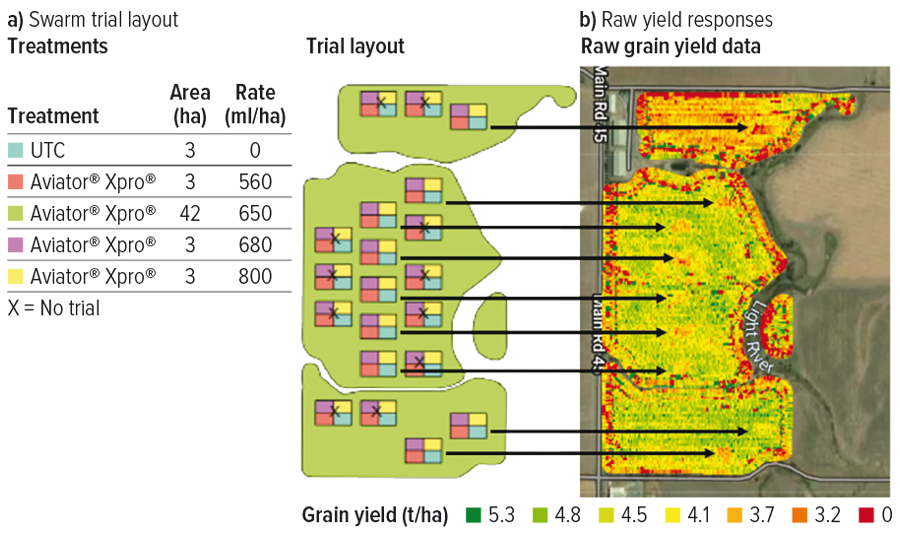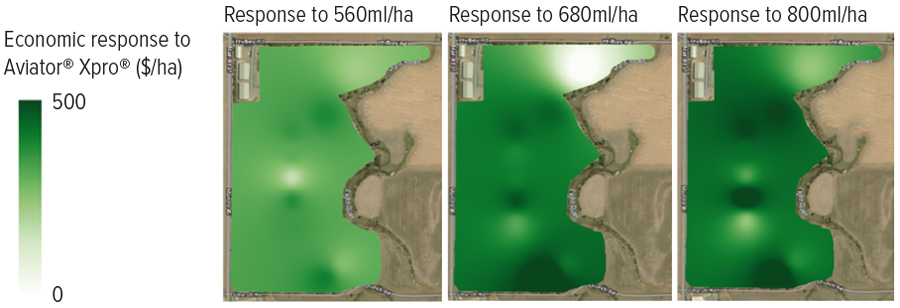Key points
- Laconik has developed a novel software solution to conduct ‘swarm trials’ across whole paddocks to capture spatial variability
- Prescription maps developed from responses to the trials can be synced with major digital platforms
- The ‘swarm trial’ data can provide a higher degree of confidence for growers in a product’s field performance
Deciphering the effects of genotype, environment and management practices on crop performance is core to the science of crop agronomy, but for decades the main platform has been small, white-pegged, plot trials.
These small plots are often confined to discrete areas or fence lines of growers’ paddocks to avoid intruding on commercial crops. This means that they might not capture environmental spatial variability for problems such as root disease, leaf diseases and soil constraints.
“Small-plot trials remove real-world variables,” says Dr Darren Hughes – and this was the driving interest for him to develop the startup company Laconik in 2017.
Dr Hughes has built a software solution that changes small trials to ‘swarm trials’ across whole paddocks.
It is a way of also addressing the lack of adoption of trial findings by placing improved on-farm experimentation in growers’ hands.
Laconik is an enabling platform. For example, many growers have the capability already on their seeders and spray rigs to apply chemicals at variable rates across their paddocks, but generally are not fully utilising these functions.
Laconik provides a way to use this data to create ‘swarms’ of trials across paddocks – capturing spatial variability and responses to a variety of fertiliser or chemical treatments, or different outcomes from crop variety or sowing rates.
The prescription maps created can be synced with major digital platforms.
These treatments are harvested with the crop and a yield map is generated. A profit gap map can then be generated from the crops’ response to the swarm trials which could be fertiliser, fungicide, insecticide or other treatments.
Laconik has worked with GRDC National Grower Network members and with GRDC support to investigate possible nitrogen carryover from frosted crops and aspects of fallow management.
The company is now partnering with several multinationals which have started using the platform to evaluate new herbicides, fungicides and biological products.
Investment support and challenges
The nature of financial investment for agronomic related startups needs to be carefully considered, Dr Hughes says.
“Unlike the ‘fast-fail’ methodology of building a typical startup, building a startup in agriculture (which is) focused on solving problems in the grains industry, means we have to work with the annual nature of the growing season. It takes 12 months to develop a new feature, test it in the paddock and gather customer feedback.”
Agriculture needs patient capital from supportive investors, he says. “At Laconik, we have been lucky to have been supported with investment from GrainInnovate and Wavemaker, a Singapore-based venture capital firm. We have leveraged investment from Australian grain growers, with capital from Asia, and have deployed it to solve problems in the Australian grains industry.”
Laconik will soon be undertaking its next capital raising to develop new software features and expand into the North American market.
Case Study: Fungicide performance at the whole paddock scale
Tim Murphy is a market development agronomist for Bayer Crop Science based in South Australia. Mr Murphy and Bayer’s market development team have been using Laconik to evaluate the grain yield and economic response to the fungicide Aviator® Xpro® at whole-of-paddock scale.
Aviator® Xpro® is registered for the control of blackleg and upper-canopy blackleg infections, sclerotinia, alternaria and powdery mildew in canola.
“At this stage of product development, we have done the small-plot trial work to obtain the label registration for upper-canopy blackleg. In 2022 it was time to demonstrate the efficacy of Aviator® Xpro® at the grower level,” Mr Murphy says.
Previously, growers would spray strips or half a paddock with a new product formulation and observe the efficacy and yield response. This approach doesn’t always provide the most accurate comparison of a product response due to the spatial variability of a paddock.
“Product performance can be affected by a range of factors including soil type, slope and elevation and air flow through the canopy, which can be highly spatially variable. Growers have been asking us to find a way to give them confidence in performance across a paddock in addition to our replicated trials.
“So, with Laconik’s swarm trial approach we can allow for this spatial variability more precisely, and capture a broader level of product performance and understanding. This results in a higher degree of confidence in the field performance of a product and its return on investment.”
Figure 1a shows the swarm trial layout on a satellite map of the farm used to evaluate Aviator® Xpro® to control both upper-canopy blackleg and sclerotinia in a canola crop. Figure 1b shows the trial responses in the raw yield data.
Disease response was ground-truthed in the swarm trials by sampling representative transects of canola plants . Each swarm trial can be easily located within the crop by recording GPS location from the spray machinery.
From this information both grain yield and economic ‘heat maps’ can be generated, highlighting the spatial variation across a paddock (Figures 1 and 2).
Figure 1: (a) Swarm trial layout to evaluate responses to different rates of Aviator® Xpro® in Pioneer® 45Y93 CL canola, South Australia 2022. (b) raw yield responses following Aviator® Xpro® application in Pioneer® 45Y93 CL canola, South Australia 2022.

Source: Laconik
Figure 2: Return on investment dollars per hectare ($ROI) paddock response to Aviator® Xpro® at three rates in Pioneer® 45Y93 CL canola, South Australia 2022.

Source: Laconik
“In this example we used Laconik’s enabling platform to demonstrate the benefit of Aviator® Xpro® fungicide application for the control of upper-canopy blackleg and ultimately yield. The resulting yield response can be seen in the return-on-investment maps,” Mr Murphy says.
“By using the swarm trials across the paddock, we were able to show that the 680 and 800 millilitres per hectare rates of Aviator® Xpro® delivered the highest return on investment. Being able to work in this way with growers and their equipment to capture greater spatial responses to our products and demonstrate these returns has been fantastic.
“Not only does the Laconik platform enable growers to see and evaluate a fungicide’s performance over greater paddock spatial variability, it builds capability amongst growers for this type of on-farm trial work as they are able to deploy the user-friendly platform, with minimal assistance from Laconik, themselves.”
More information: Laconik, Dr Darren Hughes, darren.hughes@laconik.com.au, 0436 115 462; Rick Horbury, head of market development, Bayer, 0429 055 154

























































